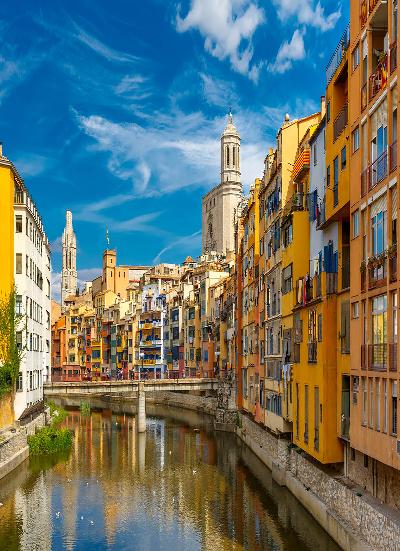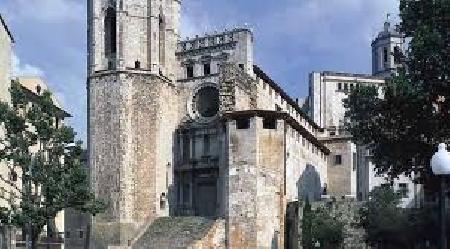 Girona is a small Catalan city located in the northeast of Spain, very close to Barcelona, the capital of Catalonia, and very close to the border with France. Girona's old town is one of the most beautiful in Catalonia.
Girona is a small Catalan city located in the northeast of Spain, very close to Barcelona, the capital of Catalonia, and very close to the border with France. Girona's old town is one of the most beautiful in Catalonia.
Girona was founded during the Roman Empire, in the year 75 AD, and served as a fortress, which at that time was called Gerund. The "Immortal City" attracts tourists with its well-preserved medieval buildings and magnificent architectural monuments.
The first settlement in Girona was founded by an Iberian tribe. Later, when the Romans arrived in Spain, they built a fortress in the territory of Girona, which the Romans called Gerunda. After the collapse of the Roman Empire, Girona fell under the power of the Visigoths, and then for several centuries it was ruled by the Arabs.
In 1015, the Arabs were finally expelled from Girona and the city became part of the Duchy of Barcelona.
Girona has always had an important strategic location. The city has survived 25 sieges in its history. Especially famous and heroic for the inhabitants of Girona were the events of 1809, when the inhabitants of the city resisted for seven months the siege of the French army.
On the banks of the Onyar river is the most picturesque neighborhood in the old town of Girona. There is also the main street of the city, the Rambla de la Libertad, where there are many shops and cafes.
The streets of Girona:
Girona is the brilliant ancient pearl of Catalonia. This medieval fortress city has a rich cultural and historical heritage from the ancient Romans to the Jews. The historic center is located on the right bank of the Onyar River, with colorful houses adjacent to the beach itself.
Arab baths:
Next to the church of San Felio is another attraction of the city: the Arab Baths. This unique 12th century Romanesque structure was modeled in the Roman baths. The historical and artistic value is the dome, the entrance area with rooms to change and rest, elegant thin columns decorated with capitals that surround the central round fountain of the bathroom. The cost of the visit to this monument is 2 euros.
Medieval walls:
Girona's old town has two areas surrounded by old fortress walls: Força Vella, which housed the original Roman city founded over 2000 years ago, and the medieval quarter that expanded it in the 14th and 15th centuries. These atmospheric ancient areas are filled with narrow pedestrian streets and impressive medieval buildings. The first urban fortifications in Girona were built by the Romans, reinforced under Charles the Great and in the 14th century. The old city walls can not only be seen, but can also be toured.
Jewish sweep:
The Jewish Quarter or El Call is one of the best preserved in Spain. It is a labyrinth of small cobbled alleys and stone stairs from the 12th and 15th centuries, which cannot be missed. In the Middle Ages, this neighborhood had an important synagogue and Kabbalah study centers.
Cathedral:
The Cathedral or Church of Santa María is one of the most spectacular attractions in Girona. The cathedral was built between the 11th and 18th centuries. It is a combination of different architectural styles, including a Romanesque cloister and the Gothic nave, which is the widest in the world. Inside the cathedral there is a museum that shows important religious works.
Onyar Pier:
The Onyar River crosses all of Girona and is an integral part of it. The famous colored houses, which cling to the riverbank, have long been a symbol of the city. We recommend seeing the stone arch bridge Pont de Pedra and the Pont de les Peixateries Velles bridge designed by Gustave Eiffel.
San Felio:
 San Felio is an impressive basilica and the first cathedral of Girona. The church was founded in the 10th century. It has a Gothic nave and a Baroque façade from the 13th to 18th centuries. The high bell tower was built between the XIV and XVI centuries.
San Felio is an impressive basilica and the first cathedral of Girona. The church was founded in the 10th century. It has a Gothic nave and a Baroque façade from the 13th to 18th centuries. The high bell tower was built between the XIV and XVI centuries.
Saint Danielle:
San Danielle is a medieval monastery built on the outskirts of Girona in a lush green valley. The monastery has the tomb of Saint Daniel.
The largest park in Girona is Devesa. It has an area of more than 40 hectares and is considered the largest in Catalonia. It is an ideal place for walks or even a small picnic.
The Pont de Pedra bridge:
The southernmost bridge located on the makeshift border of the old town and the modern Eixample district. In my opinion, it offers the best view of the Girona Canal. The Eiffel Bridge, the colorful houses and the cathedral in the background look harmonious.
Wall of the Passeig de la Muralla:
A defense structure that dates back to the Roman Empire. Some parts of the wall have been preserved since the 1st century, which is unthinkable. It is the place that I remember most in Girona. The wall offers an impressive panorama of the city.
